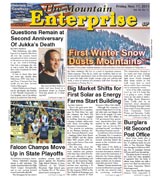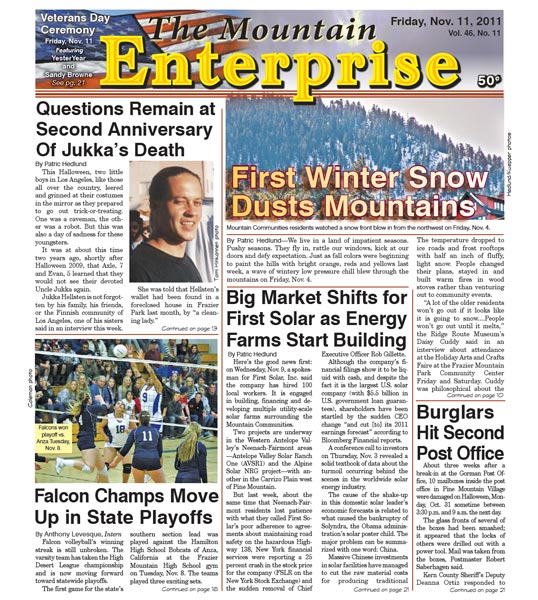By Patric Hedlund
Here’s the good news first: on Wednesday, Nov. 9, a spokesman for First Solar, Inc. said the company has hired 100 local workers. It is engaged in building, financing and developing three utility-scale solar farms surrounding the Mountain Communities.
Two projects are underway in the Western Antelope Valley’s Neenach-Fairmont areas —Antelope Valley Solar Ranch One (AVSR1) and the Alpine Solar NRG project—with another in the Carrizo Plain west of Pine Mountain.
But last week—about the same time that Neenach-Fairmont residents lost patience with what they called First Solar’s poor adherence to agreements about maintaining road safety on the hazardous Highway 138—New York financial services were reporting a 25 percent crash in the company’s stock value (FSLR on the New York Stock Exchange) and the sudden removal of Chief Executive Officer Rob Gillette.
Although the company’s financial filings show it to be liquid with cash, and despite the fact it is the largest U.S. solar company (with $5.5 billion in U.S. government loan guarantees), shareholders have been startled by the sudden CEO change and the cut in its 2011 earnings forecast, according to Bloomberg Financial reports.
A conference call to investors on Thursday, Nov. 3 revealed a solid textbook of data about the turmoil occurring behind the scenes in the worldwide solar energy industry.
The cause of the shake-up in this domestic solar leader’s economic forecasts is related to what caused the bankruptcy of Solyndra, the Obama administration’s solar poster child. The major problem can be summarized with one word: China.
Massive Chinese investments in solar facilities have managed to cut the raw material costs for producing traditional silicon-based solar panels from $400 to $40 per kilogram. That has shifted the premise for First Solar’s competitive cost strategy using an alternate technology.
All this is happening at the same time that the European Community’s subsidized demand for solar facilities is temporarily vaporizing because of the churning debt crisis there.
Mike Ahearn, chairman of the board and interim chief executive officer, said the solar industry is “feeding mostly off of legacy subsidies in California. At the same time, supply chain entry barriers for silicon have evaporated, leading to massive capacity buildup.”
Translated, that means supply exceeds demand for the moment, so First Solar—a solar panel manufacturer as well as a facilities builder—is shutting down a factory in Vietnam and will slow down manufacturing in the U.S. and Europe.
Meanwhile, building is underway on a 570 acre portion of the AVSR1 property, north of Hwy. 138, on either side of 170th. Fairmont Town Council President David Kerr has been sending open letters to First Solar personnel about what he says appear to be the company’s failures to comply with agreements under county building permits on safety measures, road access and other concerns. He said Oso Town Council representatives share these concerns and that First Solar personnel are not responding honestly or in a timely manner to community questions about hazards to public safety.
Now Construction Manager Gary Baumeister has replied that he hopes closures at 170th Street West will be lifted ahead of the 60-day permit. He said their road project has removed 300 feet of pavement and work is progressing.
This is part of the November 11, 2011 online edition of The Mountain Enterprise.
Have an opinion on this matter? We'd like to hear from you.


